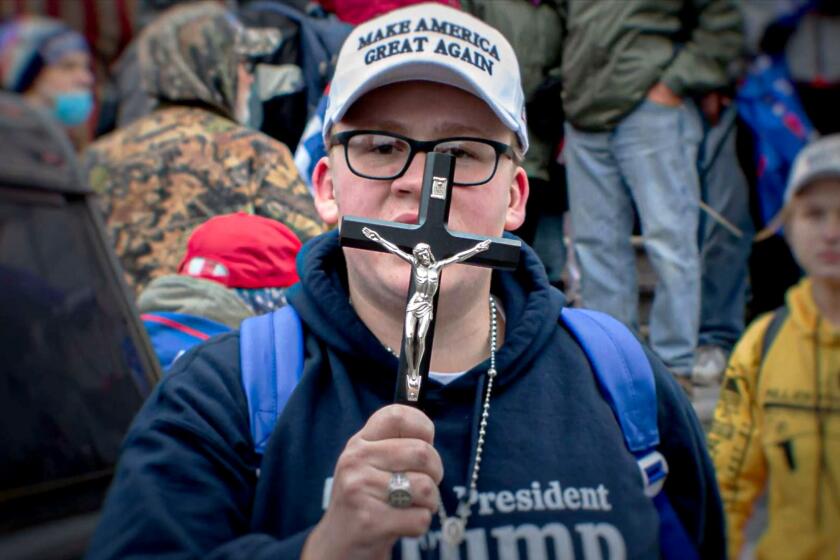J.D. Vance’s book ‘Hillbilly Elegy’ was a con job. Don’t let it slide

- Share via
The selection of J.D. Vance on Monday as Donald Trump’s running mate is a direct result of the political media’s failure to understand class in America. For his 2016 memoir, “Hillbilly Elegy,” Vance was venerated by many journalists and book critics as a powerful voice representing long-overlooked Americans. But he’s no working-class hero.
Vance portrayed this group — 35% of Americans, by the way — as tragic victims of alcoholism, drug abuse, laziness and their own self-destructive moral failings. Journalists ran with that, bringing their own stereotypes to depict the working class as angry, uneducated white men driven by economic insecurity and racist nostalgia to support Trump’s retrogressive campaign.
J.D. Vance, the Ohio senator and author of the acclaimed memoir ‘Hillbilly Elegy,’ will be the Republican vice presidential nominee, former President Trump announces.
This distortion, in turn, widened a real divide by alienating many Americans, fueling support for Trump and even veneration of Vance.
Lauded by David Brooks as the interpreter of some mythical “working-class honor code” that could illuminate the motivations of the core Trump voter, Vance was praised in reviews in the New York Times, the Washington Post and a host of other publications, and he became the go-to guy on the working-class perspective. CNN hired him as a political pundit.
This was no better than the “parachute journalism” of upper-middle-class reporters who would visit an Appalachian tavern for one afternoon and then presume to tell the nation what the working class was thinking.
Abcarian: The once-secretive right-wing ideology emerging as an overt threat to American democracy
A new documentary, ‘Bad Faith,’ explores the racist, reactionary movement driving the success of Donald Trump and being endorsed by the likes of Josh Hawley.
So who actually is the working class? Consistent data has shown that, in the words of the Center for American Progress, “Black, Hispanic, and other workers of color make up 45 percent of the working class, while non-Hispanic white workers comprise the remaining 55 percent. Nearly half of the working class is women, and 8 percent have disabilities.” Media portrayals that equate this group with uneducated white men elide most of the people who actually fit the definition.
A few contemporary reports called out Vance’s misrepresentations and the media’s fallacious thinking. In October 2016, writing for the Guardian, journalist Sarah Smarsh pointed out that exit polls and surveys showed that Trump supporters had a higher median income — $72,000 — than supporters of Hillary Clinton or Bernie Sanders. Vance himself, she reported, had been raised in a middle-class household. By ignoring such realities, Smarsh argued, “Media makers cast the white working class as a monolith and imply an old, treacherous story convenient to capitalism: that the poor are dangerous idiots.”
Another journalist, Elizabeth Catte, also notably called out national media misrepresentations, including in her 2018 book, “What You Are Getting Wrong About Appalachia.” It should have been required reading as a reality check for anyone who heard Vance on TV or read his book.
A brilliant work like Stephanie Land’s 2019 memoir, “Maid,” became the basis of a Netflix series, but even as journalists praised the book, they failed to feature her as a pundit. Kerri Arsenault’s “Mill Town,” a memoir-history of a small town in Maine, was reviewed, but again, her expertise didn’t appear in mainstream political commentary. Worst of all, when historian Steven Stoll’s masterful history of Appalachia, “Ramp Hollow,” was published in 2017, the New York Times allowed Vance himself to review it; he criticized Stoll’s “polemical” views of the market economy and dismissed the author as “earnest.”
The voices of Black historians were largely ignored, because Black voters of a certain kind were being ignored. Historian Blair LM Kelley published “Black Folk: The Roots of the Black Working Class” last fall, linking the Black working class to America’s history of slavery. It received scant media attention. Joe William Trotter’s “Workers on Arrival: Black Labor in the Making of America” suffered a similar fate, although it earned academic awards.
Ironically, before he abandoned his distrust of Trump and joined the right-wing-fringe circus, even Vance thought the media had gotten it wrong in various ways.
The news media must not fail the working class again. The stakes are too high. Trump has made clear his desire to dismantle the authority of the federal government, turn social policy over to Christian nationalists and take away any regulation of industries that contribute to climate change or that devastate communities and land through extractive practices such as fracking.
But I’m not optimistic that critics and journalists have learned much since the debacle of 2016.
When Barbara Kingsolver’s novel “Demon Copperhead” came out in October 2022, I described the book’s perspective as pitying toward the people of Appalachia while also intimating that “falling into drug abuse, rejecting education, and ‘clinging’ to their ways are moral choices that keep them in their dire circumstances. Appalachia becomes the region of the damned.”
But “Demon Copperhead” received near-universal rave reviews and won the Pulitzer Prize for fiction.
The privileged class learned all the wrong lessons from Vance’s book, if they learned anything from it. I hope more journalists will do better now that he and Trump are headed for the ballot as a package deal.
Lorraine Berry is a writer and critic in Eugene, Ore. @BerryFLW
More to Read
A cure for the common opinion
Get thought-provoking perspectives with our weekly newsletter.
You may occasionally receive promotional content from the Los Angeles Times.








